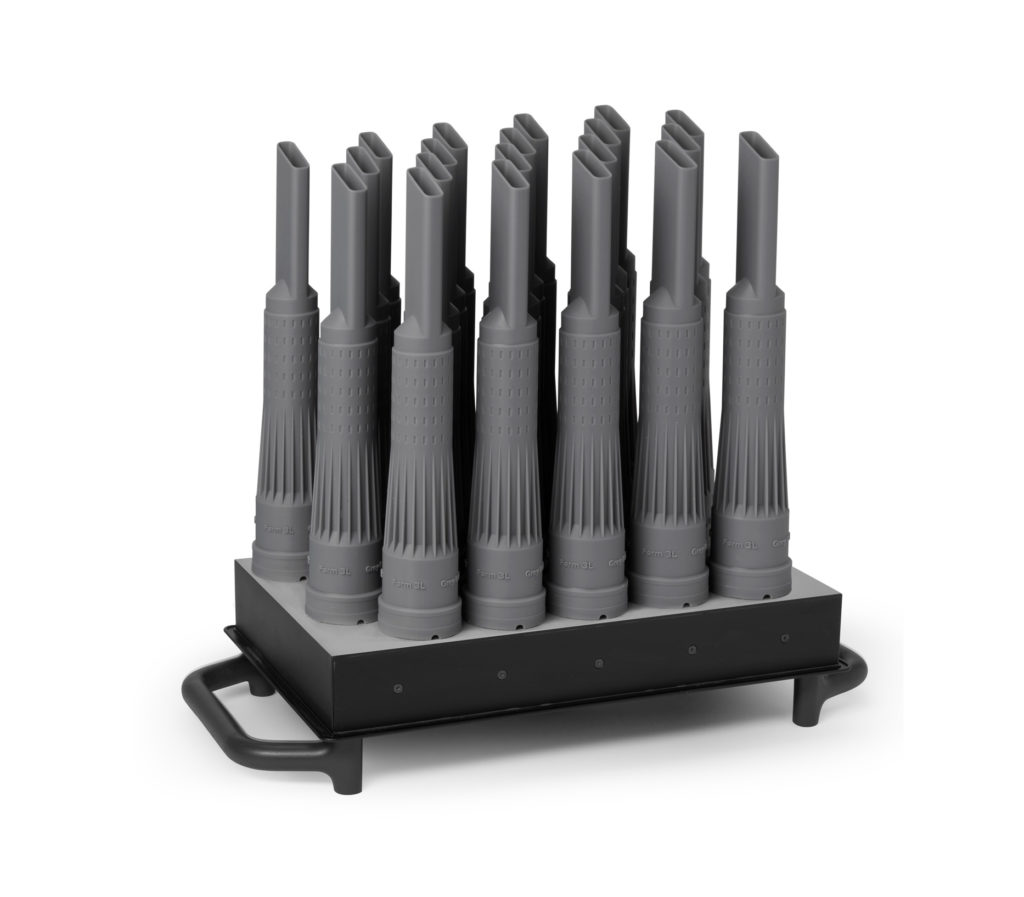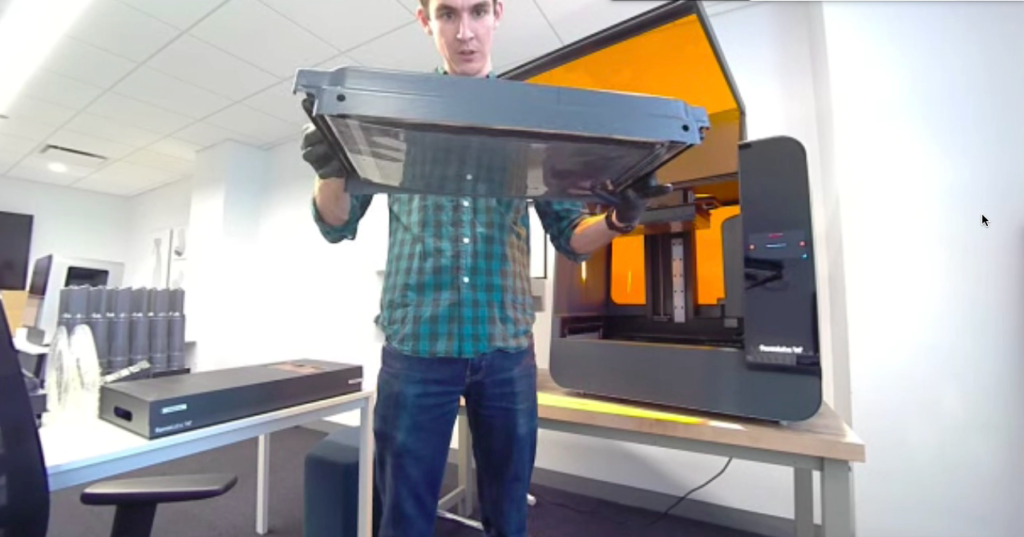Formlabs isn’t quite at the point where it’s willing to send a non-industrial user one of its large-format Form 3L units for assessment but is in the process of staging virtual reviews. I had the opportunity to check out the Form 3L stereolithography (SLA) 3D printer remotely, as Hardware Product Manager Kyle McNulty demoed the unit in his office at Formlabs HQ in Somerville, Massachusetts.
The first thing one takes note of about the Form 3L is that it is robust in size. With a sleek, office-friendly aesthetic, it looks a bit like a more polished version of what the X-Fab from DWS was meant to be, only delivered to market on time. The machine is large enough to 3D print about 21 nozzles for a vacuum cleaner, measuring 30 x 5.5 cm (11.8 x 2.2 in) each.
Customers have been asking for a large-format 3D printer since the first machine was released by the company circa 2011. In the process of re-engineering the company’s SLA technology, Formlabs also looked to scaling up the system.
“We needed to kind of re-engineer the entire print engine of the machine. And the goal was to make it even more field-maintainable,” McNulty said. “So, users didn’t necessarily have to send their printer back to one of our facilities if something happened to it after a couple of years. And then the other goal was to get even better surface finish, even finer features, fewer supports—all of the classic goals in 3D printing. And that also gives us a technology that can scale up to larger sizes. So, that’s ultimately what led to low-force stereolithography, which is the technology behind both the Form 3 and the Form 3L.”
Low-force stereolithography (LFS) is possible through a combination of a flexible film on the bottom of the resin tank and the optics beneath the vat. The flexible film reduces the peel forces from the build platform as it pulls out of resin vat. The laser system beneath the tank passes through the resin moving back and forth, curing a single line of resin at any given point. consistently deliver the beam perpendicular to the build plane. Combined, the resolution and layer height of the prints can be reduced significantly, 25 microns in the X and Y axes. In turn, a print has extremely smooth surface finish right out of the printer.
The next feature one might notice is how contained it all is. The resin tank is stored in a drawer that seems to be easy to slide in and out at the bottom of the machine. Resin cartridges are inserted into the side of the unit and, though gloves are probably a good idea, don’t seem like a requirement. This is because the machine automatically draws the photopolymer from the cartridges during the printing process, depositing only what’s necessary for the job as it progresses. This feature was made available with the Form 2 but seems particularly useful for large builds.
While the resin tank may eventually wear out and the resin will need to be replaced, the build platform generally lasts indefinitely. Cartridges are compatible for both the Form 3 and the Form 3L, in part because customers may buy both machines, one for smaller builds and the other for large-volume jobs. The machines are able to detect the material type within the cartridge using built-in EEPROM chips. They can also sense if the build platform is installed or not, an upgrade from earlier days when a user might hit print and walk away, only to find that the print didn’t succeed because there was not a build platform in place.
Formlabs has been greatly expanding its range of photopolymers, addressing as many verticals as possible with a portfolio now made up of nearly 40 materials. This includes 11 dental resins alone, as well as rigid and flexible photopolymers, castable materials and some various general-use resins. McNulty was using the Tough 2000, named for its tensile modulus strength of 2.2 GPa. The material has an elongation at break of 40 percent and relatively high impact strength, making it a tough and robust material. It is designed for housings, jigs and fixtures, connectors, and functional prototypes.
When preparing the vacuum nozzle file for printing, McNulty demonstrated a semi-automatic and manual method in Formlabs’ PreForm software. One-click print will orient the part in the optimum way for print success, adding supports. This option is best for filling up the build volume with 20 copies of a part. In contrast, the semi-manual method allows users to select the proper orientation, and then automatically generate or manually add supports. The print file can then be sent directly over WiFi to the printer or a USB drive can be used to print without an internet connection.
The software makes it possible to manage a variety of printers at once, see if printers are in use and then select the proper machine for producing the file. Before beginning the job, the printer will ensure that the cartridges have their ventilation caps open, for proper air flow, and check sensors so that the system reaches the proper printing temperature.
McNulty and I didn’t sit together for the entire 59 hours necessary to print some 20 vacuum nozzles, or even the 13 hours necessary to print just one. Had we waited for the system to finish, the printer would have made a sound, presented a pop-up on the menu screen, and sent a notification to McNulty’s smartphone or computer. Instead, we beamed ourselves forward to the end of the job, as the product manager pulled out a build platform with a completed print on it.

McNulty putting a full platform of 3D printed vacuum nozzles into the cleaning tank that ships with the machine.
The first post-processing step would be to take the build platform with prints, dripping in liquid resin, and insert the bed into the thirty seven liter rinse bucket filled with isopropyl alcohol or some other solvent. This is a substantial volume, given the fact that print cartridges hold a single liter, and most users print parts between a half-liter and two-and-a-half liters in size. Another option would be to remove smaller prints and put them in the accompanying washing basket (reminiscent of those used with deep fryers). 10 to 20 minutes later and the prints are clean.
After allowing the solvent to evaporate, post-curing may be necessary, depending on the material. For instance, Tough 2000 does require exposure to diffuse UV light to achieve its full material properties, but standard gray, clear and white resins don’t. At the moment, there is no Form Wash or Form Cure available for the Form 3L, though there are for the smaller machines. The Form Wash would automatically agitate the prints in the solvent before raising them out of the bucket to let them dry. The Form Cure would apply 360 degrees of UV light to the parts for 30 to 60 minutes. However, Formlabs is working on scaled-up versions of these machines for the Form 3L which should be released in Q4 of this year.
In the case of the vacuum nozzle, very few supports were necessary, but McNulty showed me a few other objects that would require some support removal, including an enclosure for the Medtronic ventilator, whose files were released to the public last year. Other examples included a large assembly that used to be made in multiple print runs with the smaller machine but could now be made all at once on the 3L, as well as dental arches that could be made in batches of 20 to 25 a time.
McNulty pointed out that there are not HVAC requirements for the machine other than a well-ventilated workspace, and said that it does not produce any harmful levels of volatile organic compounds. Though parts made with the Form 3L are isotropic in terms of physical properties, meaning that a part will behave the same way along the X-Y axes as it will in the Z-axis, photopolymers still aren’t quite up to the strength of thermoplastics.
“It isn’t quite like an injection molded part,” McNulty said. “That’s exactly where we want to get to. I think that’s ultimately the goal for the SLA industry that we’re all sprinting towards. But the material properties are not quite there yet. I think what I’ve been really excited about with LFS, the Form 3 and the Form 3L is the surface finish is really getting incredibly close to injection molded quality. But the material properties are not quite the point that you would get out of something like ABS. It’s not far off and I think, as we’ve released our engineering resins, the elongation at break and the impact strength specifically are getting closer and closer, but they’re not quite there yet. So, for anyone who is really taking advantage of the maximum impact strength of ABS, they’re still better off ultimately making it out of thermoplastic.”
That may be the reason that Formlabs has released the Fuse 1, Formlabs’ first selective laser sintering (SLS) 3D printer . Every technology has its benefits and, in this case, LFS seems to be amazing for extremely high-resolution prototypes, tooling, and end parts that don’t have the same strength requirements as something made from thermoplastic. For everything else, the Fuse 1 may be the way to go. And we’ll be conducting a virtual review of the Fuse 1 coming up as well.
Subscribe to Our Email Newsletter
Stay up-to-date on all the latest news from the 3D printing industry and receive information and offers from third party vendors.
You May Also Like
Gorilla Sports GE’s First 3D Printed Titanium Cast
How do you help a gorilla with a broken arm? Sounds like the start of a bad joke a zookeeper might tell, but it’s an actual dilemma recently faced by...
Nylon 3D Printed Parts Made More Functional with Coatings & Colors
Parts 3D printed from polyamide (PA, Nylon) 12 using powder bed fusion (PBF) are a mainstay in the additive manufacturing (AM) industry. While post-finishing processes have improved the porosity of...
$25M to Back Sintavia’s Largest Expansion of Metal 3D Printing Capacity Since 2019
Sintavia, the digital manufacturing company specializing in mission-critical parts for strategic sectors, announced a $25 million investment to increase its production capacity, the largest expansion to its operations since 2019....
Velo3D Initiates Public Offering in a Bid to Strengthen Financial Foundations and Drive Future Growth
Velo3D (NYSE: VLD) has been among a number of publicly traded 3D printing firms that have attempted to weather the current macroeconomic climate. After posting a challenging financial report for 2023,...
































